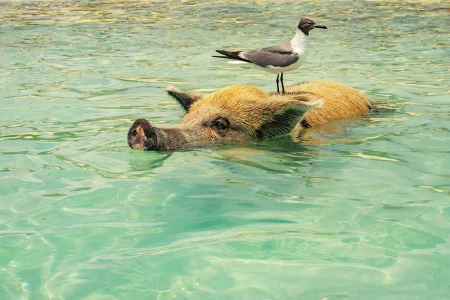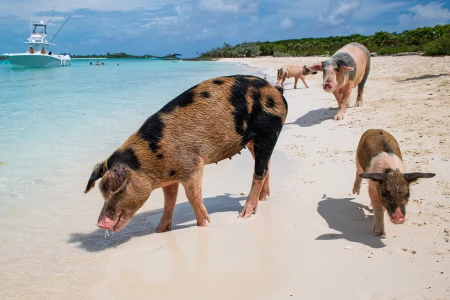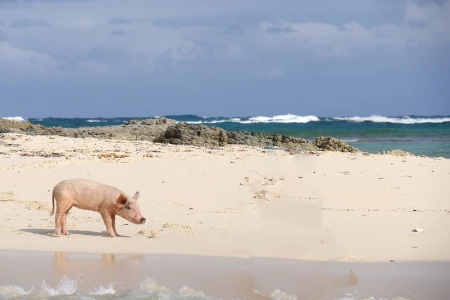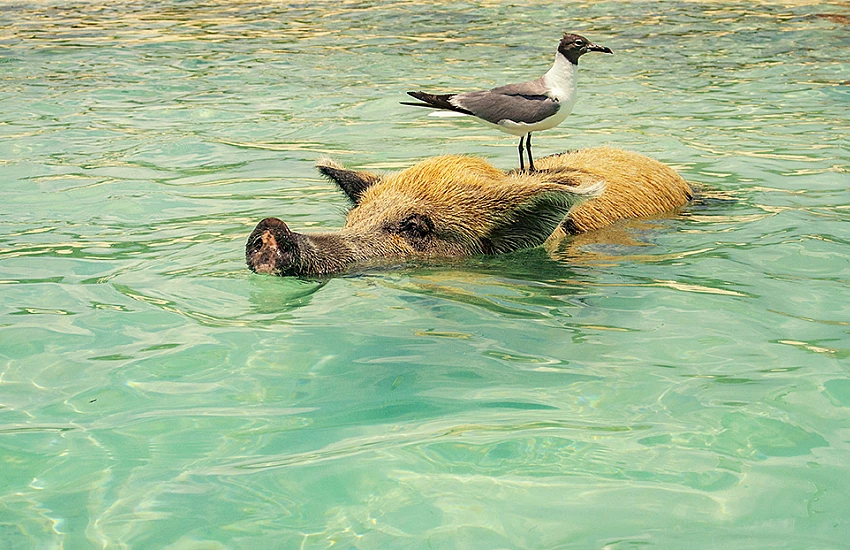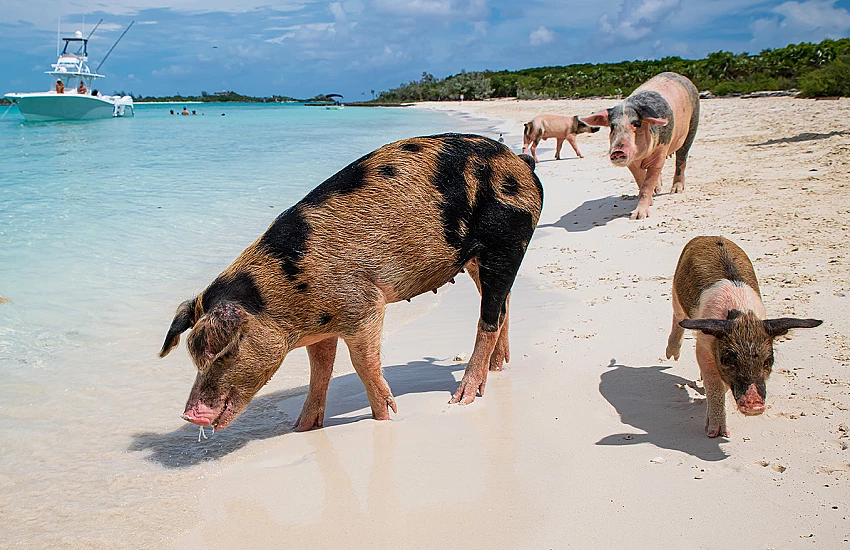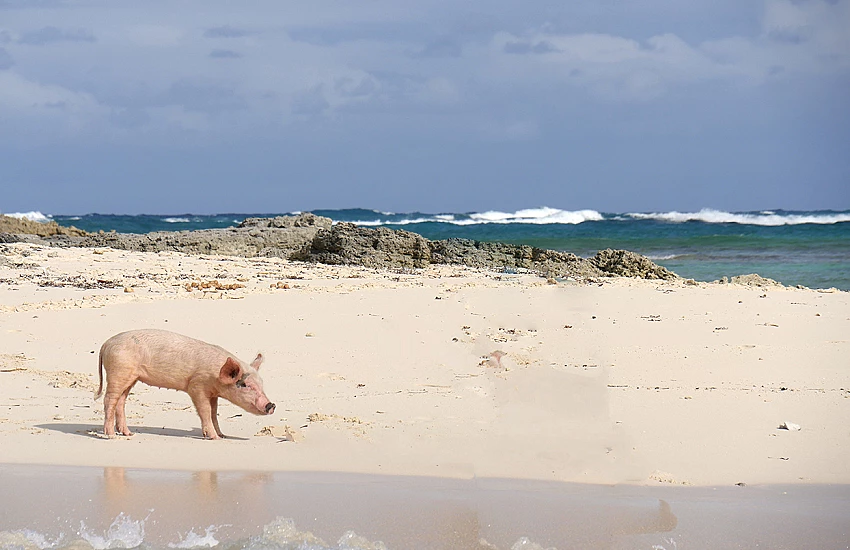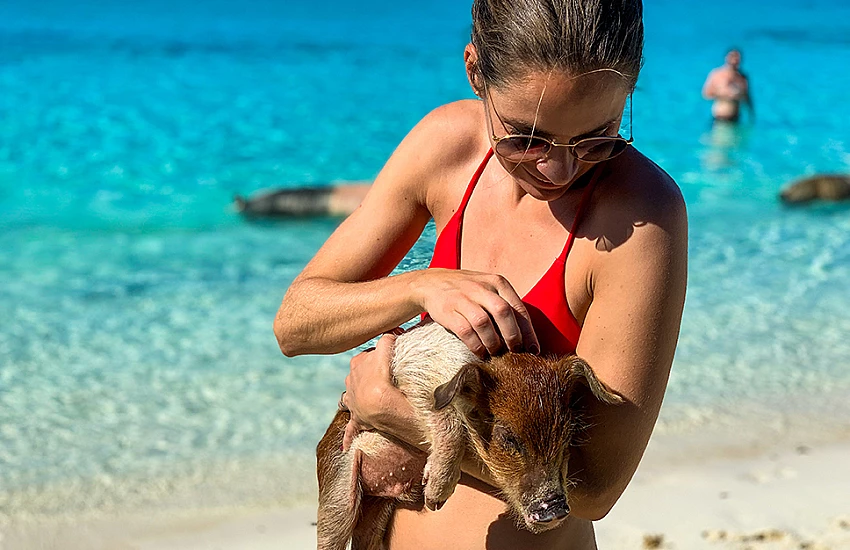
सामग्री की सूची
- The Origin Story Of The Swimming Pigs
- How To Get To Pig Beach: Travel Tips And Best Times To Visit
- Interacting With The Pigs: Do's And Don'Ts For Visitors
- Conservation Efforts: Protecting Pig Beach's Environment
- Beyond Pig Beach: Other Attractions In The Exuma Islands
- Capturing The Moment: Photography Tips At Pig Beach
Nestled within the idyllic Exuma Cays of the Bahamas, Pig Beach stands as a testament to the whimsical and unexpected wonders that nature and serendipity can create. Officially known as Big Major Cay, this uninhabited island has garnered international fame not for its pristine beaches or crystal-clear waters—though it boasts both—but for its unusual residents: a thriving colony of swimming pigs.
These charismatic creatures have turned this secluded spot into one of the most unique and endearing attractions in the Caribbean.
The origins of these aquatic pigs are shrouded in mystery, with local lore offering several colorful explanations. Some say they were left by sailors who intended to return and cook them but never did. Others believe that they swam ashore from a shipwreck, while another story suggests they were deliberately introduced by locals hoping to attract tourists. Regardless of how they arrived, these pigs have adapted remarkably well to their tropical home.
They spend their days basking in the sun, rooting around for food, and most famously, paddling out into the turquoise sea to greet visitors.
Arriving at Pig Beach feels like stepping into an enchanting storybook scene where humans and animals share a playful camaraderie. Visitors can’t help but be charmed by these friendly swine who eagerly paddle up to boats in hopes of snacks or affection. It’s an experience that defies conventional tourism tropes—a delightful blend of natural beauty and unexpected joy that leaves an indelible mark on all who visit.
The Origin Story Of The Swimming Pigs
The origin story of the swimming pigs of the Bahamas is shrouded in a blend of fact and folklore, contributing to their whimsical allure. Nestled on Big Major Cay, affectionately known as Pig Beach, these swine are believed to have arrived under mysterious circumstances that only add to their charm.
One popular legend suggests that the pigs were left by a group of sailors who intended to return and cook them but never did. The pigs thrived on the island's lush vegetation and crystal-clear waters, adapting remarkably well to their new environment. Over time, they began swimming out to meet passing boats in hopes of food scraps, a behavior that has since become iconic.
Another theory posits that the pigs were survivors of a shipwreck. Cast adrift from their vessel, they paddled through the warm Caribbean waters until they reached Big Major Cay. This narrative paints them as resilient adventurers who turned an unfortunate event into an opportunity for paradise living.
A more pragmatic explanation is that local farmers from nearby islands introduced the pigs as part of a livestock expansion effort. The uninhabited island provided a perfect free-range sanctuary without predators. Regardless of how they arrived, it's clear that human intervention played some role in establishing this unique colony.
Today, these charismatic creatures are emblematic of Bahamian hospitality and resourcefulness. Visitors flock from around the world not only to witness but also participate in this enchanting spectacle—swimming side by side with these unexpected aquatic residents in one of nature’s most delightful settings.
How To Get To Pig Beach: Travel Tips And Best Times To Visit
Getting to Pig Beach, the whimsical home of swimming pigs in the Bahamas, is an adventure in itself that adds to the allure of this unique destination. Located on Big Major Cay in the Exumas, Pig Beach is accessible primarily by boat or seaplane.
To embark on this journey, most travelers start from Nassau or George Town. From Nassau, you can take a day trip via a speedboat tour, which often includes stops at other attractions like Thunderball Grotto and Compass Cay. Alternatively, chartering a private yacht offers a more personalized experience and allows for flexible scheduling. If you're based in George Town on Great Exuma Island, local tour operators run regular excursions to Pig Beach that are shorter and more direct.
For those who prefer an aerial view of the stunning Bahamian archipelago, several companies offer seaplane flights directly to Big Major Cay. This option not only provides breathtaking vistas but also reduces travel time significantly.
When planning your visit, consider both weather and crowd conditions. The best time to visit is during the dry season from November to April when temperatures are moderate and rain showers are infrequent. This period also coincides with peak tourist season, so booking tours well in advance is advisable. Early mornings are ideal for encountering fewer crowds and enjoying calmer seas.
Regardless of how you choose to arrive or when you decide to go, visiting Pig Beach promises an unforgettable blend of natural beauty and whimsical charm unique to the Bahamas.
Interacting With The Pigs: Do's And Don'Ts For Visitors
Interacting with the swimming pigs of the Bahamas is a delightfully unique experience, but it requires a balance of enthusiasm and respect to ensure both visitors and the pigs have a positive encounter. These charismatic creatures, found primarily on Big Major Cay (often referred to as Pig Beach), are accustomed to human interaction but still require thoughtful behavior from their guests.
First and foremost, remember that these pigs are animals with their own instincts and boundaries. Approaching them slowly and calmly helps avoid startling them. While they may seem friendly and eager for treats, it’s crucial not to feed them anything other than approved foods provided by tour operators or guides. Human foods can be harmful to their health, so sticking to appropriate pig-friendly snacks like fruits and vegetables is essential.
Respecting the pigs' space is another key aspect of interaction. Allow them to come up to you rather than chasing or grabbing at them, which can cause stress or aggression. If a pig seems uninterested or walks away, let it be—forcing interaction can lead to uncomfortable situations for both parties.
Safety should always be prioritized; adult pigs can be quite large and strong. Avoid standing directly in front of a pig while feeding it as this could result in accidental nips or bites if they become overzealous about getting food.
Finally, keep in mind that while photographs make great souvenirs, your primary focus should be on ensuring that your presence doesn’t disrupt the pigs’ natural behaviors. Enjoying this whimsical attraction responsibly will not only provide you with cherished memories but also contribute to the well-being of these beloved Bahamian residents.
Conservation Efforts: Protecting Pig Beach's Environment
Pig Beach, the idyllic location in the Bahamas where visitors can swim with wild pigs, has become a symbol of whimsical allure. However, the increase in tourism has brought with it a heightened responsibility to protect this unique environment. Conservation efforts are critical to ensuring that Pig Beach remains a haven for its porcine residents and continues to captivate visitors for generations to come.
The primary concern is maintaining the delicate balance of the ecosystem. The pigs, though charming and seemingly robust, require a clean and sustainable habitat to thrive. Organizations and local authorities have implemented measures to monitor water quality rigorously, preventing contamination from human interaction. Regular assessments ensure that both the pigs and marine life are not adversely affected by pollutants.
Feeding practices have also been regulated strictly. Well-meaning tourists often unknowingly offer food that is harmful or nutritionally deficient for the pigs. To counteract this, guidelines have been established outlining appropriate feeding protocols. Volunteers and guides educate visitors on these rules, emphasizing the importance of proper nutrition for the well-being of the animals.
Waste management is another critical aspect of conservation at Pig Beach. Increased foot traffic brings an inevitable rise in littering risks. Concerted efforts have been made to install waste disposal facilities and organize frequent clean-up drives involving both locals and tourists.
Through these multifaceted conservation strategies—monitoring water quality, regulating feeding practices, and enhancing waste management—Pig Beach aims not only to preserve its enchanting charm but also ensure a sustainable future where humans and swine can continue their joyous interactions harmoniously.
Beyond Pig Beach: Other Attractions In The Exuma Islands
Beyond the enchanting shores of Pig Beach, the Exuma Islands offer a treasure trove of natural beauty and unique attractions that beckon travelers to explore further. The Exumas, an archipelago of 365 cays and islands, are renowned for their pristine beaches, crystal-clear waters, and vibrant marine life. Each island has its own charm and story to tell. One such gem is Thunderball Grotto, a captivating underwater cave system made famous by James Bond films.
Snorkelers and divers can swim through its labyrinthine passages, marveling at the kaleidoscope of coral formations and tropical fish that inhabit this submerged wonderland. The interplay of light filtering through the grotto's openings creates an otherworldly ambiance that's both serene and exhilarating. Nearby Staniel Cay offers another slice of paradise with its welcoming community and striking landscapes. Here, visitors can experience authentic Bahamian culture while enjoying local cuisine at quaint eateries or mingling with residents who embody the warmth of island hospitality.
The island’s yacht club serves as a hub for sailors exploring the Exumas' myriad hidden coves and secluded beaches. For those seeking tranquility away from tourist hotspots, Compass Cay provides an idyllic retreat. Known for its friendly nurse sharks that glide gracefully in shallow waters, this cay invites visitors to engage in unforgettable encounters with these gentle creatures. Beyond this unique interaction lies a haven for kayaking through mangroves or simply soaking up the sun on deserted stretches of sand.
The Exuma Islands are much more than just Pig Beach; they are a symphony of nature's wonders waiting to be discovered.
Capturing The Moment: Photography Tips At Pig Beach
Capturing the essence of Pig Beach requires more than just a camera; it demands an eye for spontaneity and a readiness to seize the moment. The playful pigs, with their snouts submerged in crystal-clear waters and hooves splashing joyfully, offer a mesmerizing subject for any photographer. However, the challenge lies in translating this whimsical scene into captivating images that convey both the charm of these animals and the pristine beauty of their surroundings.
Begin by familiarizing yourself with the behavior of these friendly swine. Pigs are naturally curious and may approach you out of sheer intrigue. Use this to your advantage by crouching down to their level, creating more intimate and engaging shots. Capture their expressions by focusing on their eyes or snouts as they nuzzle up to your lens. Timing is everything at Pig Beach.
Early mornings offer softer light that bathes the scene in a golden hue, enhancing both the pigs’ pinkish tones and the turquoise water. As midday approaches, harsher sunlight can cast unflattering shadows; instead, look for moments when clouds diffuse the light naturally. Consider wide-angle shots that encapsulate not just the pigs but also their stunning habitat—the vast expanse of blue sky meeting azure waves creates an idyllic backdrop.
Action shots are equally compelling: capture mid-splash moments or a pig playfully interacting with visitors. Lastly, don’t forget underwater photography if you have waterproof equipment. The sight of pigs paddling beneath clear waters adds another layer of magic to your visual narrative.






